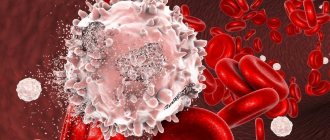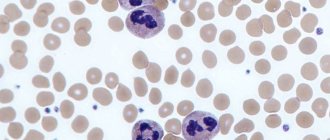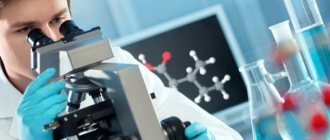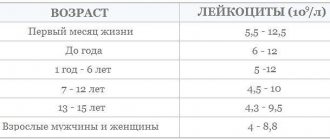The immune reactions of a healthy body vigilantly protect it, ensuring vitality and dynamic balance of the body with the external environment. However, quite often, for a variety of reasons, immune responses are disrupted. Then various diseases may arise. Interestingly, according to the World Health Organization, almost all diseases are accompanied by some degree of immune system failure. For example, increases in immune responses cause allergies, while decreases in immune responses lead to immunodeficiency states. With a severe decrease in immunity, the body’s defenses weaken so much that many types of bacterial and viral microflora begin to actively function, manifested by chronic inflammatory processes. This is especially clearly seen in the pathogens of herpes, chlamydia, viral hepatitis and many others. With the long-term course of these diseases, immunity is further reduced, which leads to an additional danger - the risk of oncological changes. In immunology, congenital immunodeficiencies are distinguished, which are caused by a genetic defect in one or more components of the immune system. Currently, more than 70 congenital defects of the immune system have been identified; they differ in depth and consistency, but are quite rare. And only early diagnosis and treatment can prevent the development of irreversible infectious and inflammatory lesions. Much more often, immunity is impaired at a later age and is acquired in nature. The most striking example of an acquired form in immunology is AIDS. A decrease in protective forces can also be caused by such reasons as X-ray irradiation, the effects of corticosteroids, cytostatics, injuries and surgical interventions, diabetes, kidney and liver diseases, malignant neoplasms, etc. However, in many cases, when the cause is eliminated, the function of the immune system is restored. It is possible to assess the state of the immune system using an immune status test. Immune status is indicators of the functioning of the immune system. It includes the study of quantitative indicators of the components of the immune system and determination of their functional activity. An indication for prescribing an immunological status study may be any suspicion of inadequate functioning of the immune system: severe infectious diseases, the presence of chronic or often recurrent infectious diseases, the presence of foci of chronic inflammation, connective tissue diseases, autoimmune processes, etc. Among the disorders of the immune system, the first The following should be highlighted:
- Insufficiency of the immune system or immunodeficiency is a reduced activity of the immune system, which develops as a result of a reduced number of components of the immune system or their insufficient functional activity.
- Hyperreactivity of the immune system, in other words – excessive activity, which can lead to a severe course of the disease that caused it.
- Autoimmune reactions (the immune system attacks its own tissues).
Assessing the immune status allows you to clarify the diagnosis of the disease, as well as determine treatment tactics if abnormalities in the functioning of the immune system are detected (immunotropic drugs can be prescribed or replacement therapy can be carried out by administering immune sera, immunoglobulins, leukocyte mass, interferon preparations). To do an immunogram (a comprehensive study of the state of the immune system), you need to take blood from a vein for analysis. Based on the results of this analysis, one can judge whether the human body is able to protect itself from bacteria and viruses that constantly attack it, whether it has enough cells and molecules designed to maintain the constancy of the internal environment, and also what the ratio of such cells and molecules is. The immunogram takes into account the number of cells (leukocytes, macrophages or phagocytes), their percentage and functional activity, as well as the “substances” that these cells produce - immunoglobulins (Ig) of classes A, M, G, E, components of the complement system. To find out all this, a number of blood cells are examined - leukocytes: granulocytes, monocytes, but primarily lymphocytes. Another important indicator is the amount of immunoglobulins that protect the body from microbes. Along with this, the presence and activity of interferons is determined (these are molecules that protect us from germs, viruses and tumor growth). The ability of blood cells to respond to incoming microorganisms is also tested.
general characteristics
CECs are complexes consisting of antigen, antibodies and associated complement components C3, C4, C1q. Normally, immune complexes formed in the bloodstream are phagocytosed and destroyed by both phagocytes and the liver. However, with an increase in their size (with an excess of antigen and the presence of IgM and the C1q component of complement in their structure), the complexes can be deposited in the perivascular space and the renal cortex, causing activation of complement and inflammatory processes. More often, immune complexes are deposited in the endothelium of blood vessels, renal glomeruli, and joints, which, accordingly, manifests itself in clinical signs of vasculitis, glomerulonephritis, and arthritis. The pathogenesis of autoimmune diseases is closely related to the accumulation of immune complexes in tissues.
Immune system cells
Leukocytes . Their purpose is to recognize foreign substances and microorganisms, fight them, and also remember information about them. There are several types of leukocytes: - lymphocytes: B-lymphocytes get their name from the Latin word “bursa” - bursa (named after the bursa of Fabricius - the organ in which B-lymphocytes mature in birds. In humans, this process occurs in the bone marrow). This type of lymphocyte produces antibodies (immunoglobulins). T lymphocytes control the work of B lymphocytes, that is, the production of antibodies. They got their name from the word “thymus” - the organ in which their maturation occurs. ٭The thymus is the same as the thymus gland. T-helpers are a type of T-lymphocytes that help synthesize antibodies (to help). T-suppressors are a type of T-lymphocytes that suppress the synthesis of antibodies (to suppress, suppress, restrain, prohibit). — natural killer cells (NK) are lymphocyte-like cells that lack the characteristics of T- and B-lymphocytes. They are able to destroy tumor cells and cells infected with viruses; - neutrophilic leukocytes (band-nucleus: the nucleus looks like curved rods; segmented: the nuclei are segmented, have constrictions); - eosinophilic leukocytes; - basophilic leukocytes. Neutrophils, eosinophils and basophils are types of leukocytes, but these cells do not perceive dyes in the same way, which is why they have different names. Eosinophils are involved in the destruction of parasites (they secrete special enzymes that have a damaging effect on them), as well as in allergic reactions (they secrete substances that destroy histamine, preventing the release of enzymes from mast cell granules). Neutrophils are sometimes called "microphagocytes", referring to their ability to phagocytose microorganisms. Macrophages, or phagocytes, “eat” living and dead microbes, antigen-antibody complexes (formed in the process of fighting viruses, bacteria and their toxins), dead cells of the body itself. Without these cells, the activity of lymphocytes is impossible, since they are the ones who “help” the latter recognize antigens and secrete mediators (substances that stimulate or inhibit the activity of other cells of the immune system). The average number of microbes engulfed by one phagocytic cell is called the phagocytic number, and the percentage of phagocytic macrophages is called the phagocytic index. On the surface of cells there are antigens - unique markers (labels) that distinguish some cells from others. These are called clusters of differentiation (CDs). What marks are on the surface of the cell depends on its type (T-lymphocyte, B-lymphocyte, etc.) and its maturity (ability to perform its functions). Labels are numbered in turn, according to when they were opened: the earlier the cluster was opened, the lower its number. In laboratories, clusters of differentiation are detected using monoclonal antibodies. ٭A clone is a collection of cells arising from one common cell. The clone cells are 100% identical. Identical cells synthesize identical antibodies, which are called monoclonal.
The most common types of clusters are: CD2 - cluster of T-lymphocytes, NK-cells; CD3 - T-lymphocyte cluster; CD4 - T-helper cluster; CD8 – T-suppressor cluster; CD16 – cluster of NK cells (natural killer cells); CD20 is a cluster of B cells. Immunoglobulin testing provides information about the state of the humoral immune system. This is used in the diagnosis of primary and secondary immunodeficiencies, autoimmune, infectious, hematological and other diseases. Changes in immunological parameters can be a manifestation of the body’s normal reaction to the influence of physiological or pathological factors (with different patterns of changes at different stages of the disease), reflect excessive activation, depletion of the immune system, or characterize a congenital or acquired defect of individual parts of the immune system.
There are four types of immunoglobulins: IgM - this type of antibody appears first upon contact with an antigen (microbe). An increase in their titer, or content in the blood, indicates an acute inflammatory process. IgG - antibodies of this class appear some time after contact with the antigen. They participate in the fight against microbes: they bind to antigens on the surface of the bacterial cell; then other plasma proteins (the so-called complement) join them, as a result of which the bacterial cell is lysed (its membrane ruptures). In addition, IgG is involved in some allergic reactions. IgA prevents the penetration of microorganisms through mucous membranes. IgE - antibodies of this class interact with receptors located on mast cells (connective tissue cells that secrete physiologically active substances: heparin, histamine, serotonin, etc. They are involved in the processes of inflammation, blood clotting, etc.) and basophils. As a result, histamine and other allergy mediators are released. An allergic reaction itself develops. One of the most important indicators of immune status is complement components C3, C 4. Complement is the set of immune proteins contained in fresh blood serum. They participate in the bactericidal action of blood. C3 is a central component of the complement system, an acute phase protein of inflammation. This is an essential part of the defense system against infections. It is formed in the liver, macrophages, fibroblasts, lymphoid tissue and skin. Therefore, disruption of their normal state significantly affects this component. C4 is a glycoprotein synthesized in the lungs and bone tissue. C4 supports phagocytosis, increases the permeability of the vascular wall, and is involved in the neutralization of viruses. This test is usually prescribed for suspected autoimmune disorders, repeated bacterial infections; during dynamic observation of patients with systemic autoimmune diseases; in the diagnosis of systemic lupus erythematosus, rheumatoid vasculitis and other diseases. Another indicator of immune status is cryoglobulin, an abnormal protein that can be present in the blood in a number of diseases. At low temperatures, cryoglobulins become insoluble, leading to blockage of small blood vessels located in the fingers and toes in cold weather, causing the characteristic rash. The presence of cryoglobulins (cryoglobulinemia) can be a symptom of various diseases, including macroglobulinemia, systemic lupus erythematosus, as well as a number of infectious diseases. Interferons are a special group of proteins that are produced by cells of the human immune system. They are a type of weapon with which the body can resist pathogenic bacteria, parasites and even cancer cells. There are three main classes of interferons: interferon alpha (α), interferon beta (β), interferon gamma (γ), and interferon omega (ω). All of them not only have antiviral and antitumor effects, but also have the property of activating - forcing other protective factors - macrophages and natural killer cells - to act. All types of interferon have a very strong influence on the course of RNA viral infections. In most cases, interferon production is provoked by the penetration of bacteria, viruses or their metabolic products into the body.
Clinical relevance
Pathological reactions to immune complexes can be caused by an increase in the rate of their formation above the rate of elimination, a deficiency of one or more complement components, or functional defects of the phagocytic system. Determining the level of immune complexes in blood serum is important in the diagnosis of acute inflammatory processes in the body and is an indicator of the activity of autoimmune diseases, type III allergic reactions, in which the level of CEC increases, as well as in assessing the effectiveness of treatment.
Detailed description of the study
Complement is a system of serum proteins that are involved in inflammation and help destroy foreign agents by damaging their cell membranes. Complement includes about 30 proteins, all of which are produced in the liver.
The complement system is an integral part of the human immune system. It is activated when an antigen enters the bloodstream - this is any substance foreign to the body. An antigen can be external (microorganisms, drugs) and internal molecules (tumor antigens, the body's own cells). During the development of an immune response, antigen-antibody complexes are formed, which are also called circulating immune complexes (CIC).
CECs are compounds formed when antibodies meet antigens in the blood. They are high-molecular aggregates of antibodies of the IgG and IgM classes, complement components and antigen. CECs contribute to the humoral immune defense of the body - they bind and neutralize foreign antigens for their subsequent destruction/removal from the body.
Normally, circulating immune complexes are utilized by protective cells—phagocytes and macrophages—immediately after their appearance in the blood serum. When there is an excessive amount of antigens in the bloodstream (for example, the circulation of microorganisms during long-term infectious pathology), a compensatory increase in the CEC in the serum is observed. Moreover, their excess concentration cannot always be utilized by phagocytes in full - a condition arises when a large number of immune complexes circulate freely in the blood.
As a result, they begin to be deposited in various organs and tissues, especially in the joints and in the endothelium of blood vessels. Vessels with slow blood flow or those where the filtration process occurs (glomeruli) are most at risk. When deposited in tissues, circulating complexes activate the complement system, which causes the development of an autoimmune disease directed against the body’s own healthy cells.
Autoimmune pathologies associated with CIC are called immune complex diseases (ICDs), or allergic hypersensitivity reactions of type III. They are based on the classical pathway of activation of the complement system using the antigen-antibody complex. The main clinical manifestations of BIC are vasculitis, glomerulonephritis and arthritis.
Serum sickness is also a type of CIC - a pathology that occurs when foreign serum proteins enter the bloodstream through injection and contributes to the formation of an excess amount of CIC. In this case, the antigen is foreign proteins (proteins from vaccines, donor serum, drugs), and not a microorganism.
However, an increase in the CEC does not always mean their involvement in the development of pathology. It is necessary to compare the indicator with complaints, the clinical picture and the results of other diagnostic examinations.
Interpretation:
- An increase in the level of CEC in the blood is characteristic of: • Acute bacterial, fungal, parasitic and viral infections. • Autoimmune diseases, collagenosis, rheumatism, glomerulonephritis, allergic alveolitis, vasculitis, Arthus phenomenon. • Immune complex diseases, serum sickness. • Allergic reactions of the 3rd type.
- A decrease in the level of CEC during the disease or during treatment indicates the extinction of the inflammatory process and the effectiveness of therapy.
Sample result (PDF)
Clinical blood test with leukocyte formula
A clinical blood test with a leukocyte formula can identify many diseases. It reflects the state of hematopoiesis - the maturation and growth of blood cells in the bone marrow. The state of the immune system is indicated by the levels of white blood cells - leukocytes and the leukocyte formula. Monitoring the leukocyte formula in the dynamics of the disease will reveal complications, the spread of infection throughout the body, and the response to treatment.
With bacterial infections, you can see an increase in leukocytes and neutrophils with the appearance of their young forms in the blood.
With viral infections, on the contrary, leukocytes decrease, and lymphocytes predominate in the leukocyte formula.
The predominance of certain populations in the leukocyte formula helps in diagnosing the cause of inflammation. For example, in certain infections (for example, infectious mononucleosis), altered monocytes increase, and in allergic and parasitic diseases, eosinophils increase.
The presence of very young cells (blasts) in the blood is a sign of excessive activation of the bone marrow, and a low level of leukocytes and neutrophils without inflammation is a sign of its suppression.
Immunoglobulins A, M, G, E
Total immunoglobulins are indicators of the humoral immune response. IgM levels increase during the acute period of the disease and during exacerbation of chronic infection, IgG - during the recovery process, IgA - during the acute period of the disease, persisting longer than IgM, reflecting a protracted course and damage to the mucous membranes. Elevated IgE levels indicate allergic inflammation.
General immunoglobulins do not explain the cause of infection, so it is advisable to look at specific antibodies to specific pathogens. The main indications for determining total antibodies are suspicion of congenital immunodeficiency associated with humoral immunity.
Total immunoglobulin E, immunoglobulin G, immunoglobulin M, immunoglobulin A are examined.
Lymphocytes, immunophenotyping
There are different populations of lymphocytes that play a key role in directing the immune response - cellular or humoral. Determination of the immune phenotype of a lymphocyte is possible in a special study using flow cytometry. The phenotype of lymphocytes depends on special receptors on their surface - CD differentiation clusters. The presence of one or another receptor indicates that the cell belongs to a certain population of lymphocytes.
Cellular immunity is determined:
- B lymphocytes (CD19+)
- T-lymphocytes (CD3+) common and their subtypes:
- T helper cells (CD3+CD4+)
- T-cytotoxic (CD3+CD8+)
- T-killer cells (CD3+CD16+CD56+)
- Natural killer cells (CD3-CD16+CD56+)
- Lymphocytes with HLA-DR+ marker
- Immunoregulatory index (T-helpers/T-cytotoxic)
Additionally, other lymphocyte CD markers are examined to determine their activity.
Evaluation of the result is possible only in conjunction with data from the clinical picture and immunomodulatory therapy. Immunophenotyping of lymphocytes is usually carried out over time. Thus, in HIV infection that affects T-helper cells, a decrease in the level of CD3+CD4+ cells and the immunoregulatory index (CD3+CD4+/CD3+CD8+) has a poor prognosis for the course of the disease.









